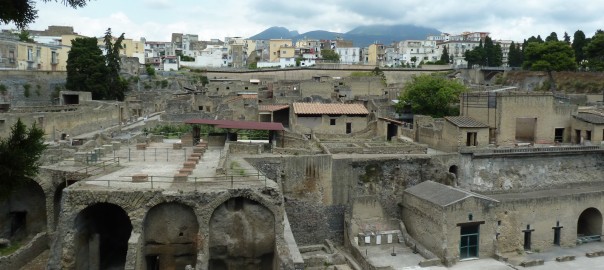Catastrophe and Apocalypse in Herculaneum is a nine-session module at the 200-level, developed and contributed by the St. Olaf College curricular team (Trull, Casson, and Thompson).
The module emphasizes the links between natural environment, material conditions, and political thought. It is designed to take about nine class hours to complete (approximately three weeks of class in a standard semester), during the middle or end of the term, after introductory concepts are established. The module has a great deal of flexibility; components may be adapted to courses in diverse departments, and components may be positioned at various points in a semester. At St. Olaf College, the module has been used in a literary course taught off-campus, an art history course in Italy, and in a Classical Political Thought course that in the past has focused exclusively on philosophical texts.
Description of curricular project: Catastrophe and Apocalypse in Herculaneum
Fresco from a wall in Herculaneum, that is the focus of an assignment, “Understanding Art through Place and Material Culture.”
Course descriptions and resources
This January interim course, developed by Professor Mary Trull and offered by the English Department, explores urban ecology through interdisciplinary readings and activities, with special attention to understanding how a city and its literature are shaped by land, water, technology, and natural catastrophes in specific places and times. Starting with ancient Rome, the course then moves to 17th- and 18th-century London, and ends with contemporary Los Angeles. It explores t he eruption of Mt. Vesuvius in 79 CE, the Great Fire of London in 1666, and Rodney King’s beating and the social upheaval of 1992, as historical and ecological events that illuminate human perspectives on Catastrophe and Apocalypse.
Assignment- Understanding Poetry through Place and Material Culture
Assignment- Point Paper: Epicurean and Stoic Responses to Suffering
2. Italian Art in Context: The City of Florence
Taught in Italy by Professor Nancy Thompson, this course offers an intensive introduction to the history of the art and architecture of Florence. Through a study of Florence’s topography and geography, its built environment and painted and sculpted imagery, students investigate first-hand the history of Florence from its inception as a Roman colony through the nineteenth century when Florence was the capital of the newly unified Italian nation. A central focus of the month-long study is the ways that human-built cities interact with and are affected by rivers, mountains, hills and volcanoes. Students’ study of Florence is enriched by travel to other cities such as Siena, Pisa, Rome, and Pompeii, where they hike to the top of Mt. Vesuvius. Syllabus and full course materials are in the testing phase, this month. This lecture is one component of the January interim course:
Lecture on Pompeii and Augustan Rome
3. History of Classical Political Thought
Professor Doug Casson begins this course with Socrates’ fundamental question: “What is justice?”, which founded political philosophy. Students study the responses of different ancient Greek, Roman, and early Christian philosophers to Socrates’ question, focusing especially on the relationship between truth-seeking and community-formation. The Catastrophe and Apocalypse module will help students move beyond traditional approaches to ancient philosophy and engage them in an interdisciplinary study of ethics and justice in the ancient world. By combining close readings of philosophical texts with historical, environmental, economic, and political considerations, students will be encouraged to draw connections between these ancient texts and contemporary political themes.
